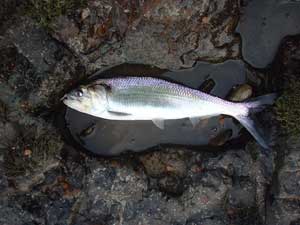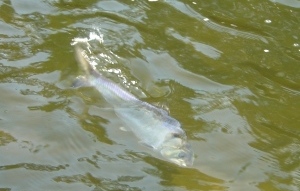Shad


Shad are a member of the herring family that return from the sea to spawn in spring, usually between April and May (hence the alternative name of 'May fish'). There are two types in the Wye and Usk: Twaite shad (Alosa fallax) and Allis shad (Alosa alosa). It is difficult to distinguish these close relatives. Both fish have streamlined bodies covered with distinct, large, circular scales which form a toothed edge on the lower margin and an adipose membrane which partially covers each eye. Rarely exceeding 40 cm length, Twaite shad are usually smaller than Allis, which measure 30-50 cm.
On the Wye and Usk, Twaite shad are known to spawn at night on gravels and sands at the tail of deeper pools, in which the fish congregate. The majority of adults die after spawning, with about 25% returning to spawn more than once.
Relatively little information is available on the habitat requirements of Allis shad in freshwater. It spends its adult life in coastal waters and estuaries but migrates into rivers to spawn, swimming up to 800 km upstream in continental Europe. However, Allis shad do not readily traverse obstacles to migration such as dams, weirs or bridge footings and this has been a major cause of their decline. Like Twaite shad, adults spawn at night with a great deal of noisy splashing; the eggs are released into the current where they settle among gaps in gravelly substrates. Spawning sites tend to be used year after year. Almost all adult Allis die after spawning.
Twaite shad are found along the western coastline of Europe, from southern Norway to Morocco and along the eastern Mediterranean, but have declined substantially throughout Europe. Allis shad are rare and declining throughout their range on the western coasts of Europe, from southern Norway to Spain, and in the Mediterranean eastwards to northern Italy. The most successful breeding populations are thought to be in a few rivers in western France and Portugal. Population declines in both species in many parts of Europe have been attributed to pollution, overfishing and migratory route obstructions.
In the UK, spawning stocks of Twaite shad are known to occur in only a few rivers in England & Wales. No spawning stocks are known north of the Severn estuary, although the species is present in south-west Scotland, in rivers flowing into the Solway Firth, where hybrids with Allis shad have been reported. Although formerly known to spawn in several British river systems, the only recently-confirmed spawning site is in the Tamar Estuary (Plymouth Sound and Estuaries cSAC).
Twaite shad remain abundant in the Wye, which contains the largest spawning population in the UK of this species. Determination of whether Allis shad are present and where they spawn has not been made but in recent years some outsized "Twaite" shad have been caught by anglers, which were almost certainly Allis or Allis/Twaite crosses. The Foundation was responsible for the purchase of commercial fisheries in the estuary that formerly took a considerable number of shad.
The best chance of seeing this species is in May and June when large shoals tend to swim in a quick, circular fashion in the deeper pools. They may also be observed charging around in the shallower water later in the evening during spawning. Please note that fishing for shad is illegal.
